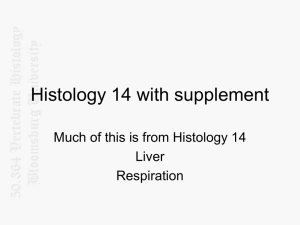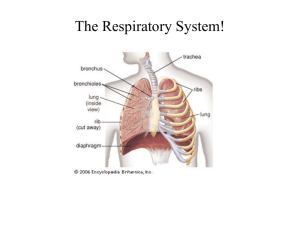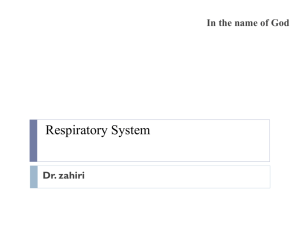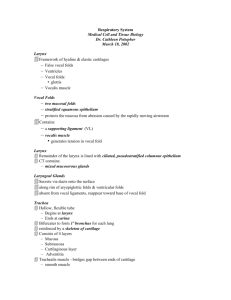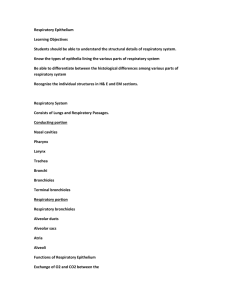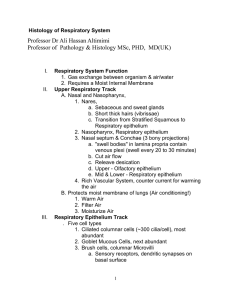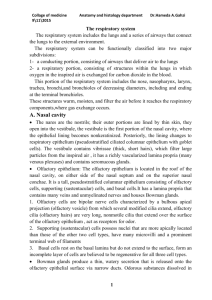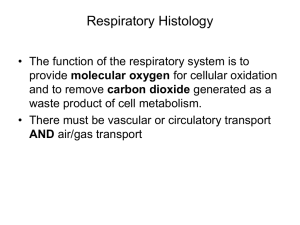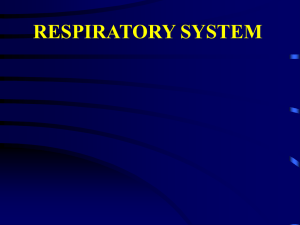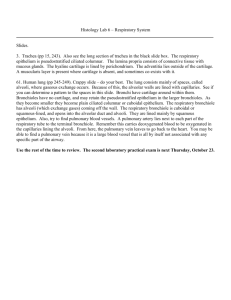The Respiratory System: Sept. 29 – Dirksen
advertisement
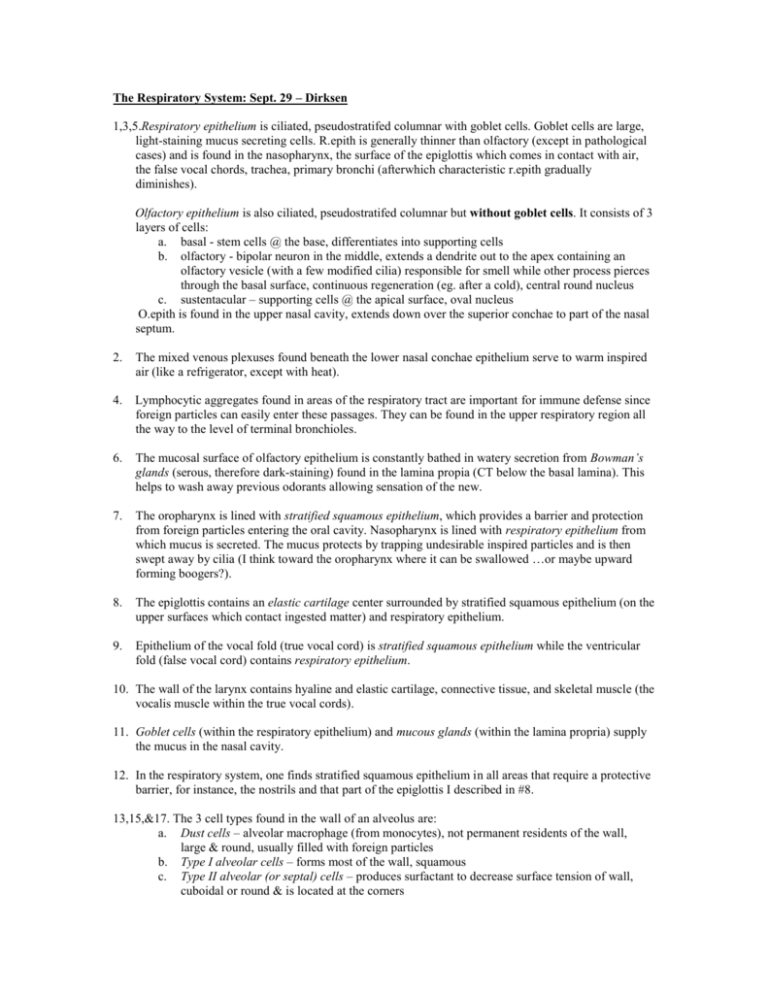
The Respiratory System: Sept. 29 – Dirksen 1,3,5.Respiratory epithelium is ciliated, pseudostratifed columnar with goblet cells. Goblet cells are large, light-staining mucus secreting cells. R.epith is generally thinner than olfactory (except in pathological cases) and is found in the nasopharynx, the surface of the epiglottis which comes in contact with air, the false vocal chords, trachea, primary bronchi (afterwhich characteristic r.epith gradually diminishes). Olfactory epithelium is also ciliated, pseudostratifed columnar but without goblet cells. It consists of 3 layers of cells: a. basal - stem cells @ the base, differentiates into supporting cells b. olfactory - bipolar neuron in the middle, extends a dendrite out to the apex containing an olfactory vesicle (with a few modified cilia) responsible for smell while other process pierces through the basal surface, continuous regeneration (eg. after a cold), central round nucleus c. sustentacular – supporting cells @ the apical surface, oval nucleus O.epith is found in the upper nasal cavity, extends down over the superior conchae to part of the nasal septum. 2. The mixed venous plexuses found beneath the lower nasal conchae epithelium serve to warm inspired air (like a refrigerator, except with heat). 4. Lymphocytic aggregates found in areas of the respiratory tract are important for immune defense since foreign particles can easily enter these passages. They can be found in the upper respiratory region all the way to the level of terminal bronchioles. 6. The mucosal surface of olfactory epithelium is constantly bathed in watery secretion from Bowman’s glands (serous, therefore dark-staining) found in the lamina propia (CT below the basal lamina). This helps to wash away previous odorants allowing sensation of the new. 7. The oropharynx is lined with stratified squamous epithelium, which provides a barrier and protection from foreign particles entering the oral cavity. Nasopharynx is lined with respiratory epithelium from which mucus is secreted. The mucus protects by trapping undesirable inspired particles and is then swept away by cilia (I think toward the oropharynx where it can be swallowed …or maybe upward forming boogers?). 8. The epiglottis contains an elastic cartilage center surrounded by stratified squamous epithelium (on the upper surfaces which contact ingested matter) and respiratory epithelium. 9. Epithelium of the vocal fold (true vocal cord) is stratified squamous epithelium while the ventricular fold (false vocal cord) contains respiratory epithelium. 10. The wall of the larynx contains hyaline and elastic cartilage, connective tissue, and skeletal muscle (the vocalis muscle within the true vocal cords). 11. Goblet cells (within the respiratory epithelium) and mucous glands (within the lamina propria) supply the mucus in the nasal cavity. 12. In the respiratory system, one finds stratified squamous epithelium in all areas that require a protective barrier, for instance, the nostrils and that part of the epiglottis I described in #8. 13,15,&17. The 3 cell types found in the wall of an alveolus are: a. Dust cells – alveolar macrophage (from monocytes), not permanent residents of the wall, large & round, usually filled with foreign particles b. Type I alveolar cells – forms most of the wall, squamous c. Type II alveolar (or septal) cells – produces surfactant to decrease surface tension of wall, cuboidal or round & is located at the corners 14&18. Histological differentiation of: a. respiratory bronchiole – lined by cuboidal epithelium resting on a little bit of smooth muscle and connective tissue, also scattered with alveoli (therefore, this is the first level where gas exchange can occur) which are NOT in direct contact with pulmonary arteries, cilia found proximally, terminates at 2 alveolar ducts, (NOTE: Clara cells, which cannot be seen in the slides, also may secrete surfactants.) b. alveolar duct – branches of respiratory bronchioles whose wall is made of individual alveoli or alveolar sacs (looks like a cul-de-sac), terminates at multiple alveolar sacs 16&20.O2/CO2 exchange involves crossing the alveolar membrane which consists of: capillary endothelial cell, Type I alveolar cell (lined with a layer of surfactant), and the fused basal lamina of the two found in between. The basal lamina is composed mainly of proteoglycans, type IV collagen, and laminin. Gas exchange does not occur at the terminal bronchioles since there are no alveoli. 19. Lung structures where smooth muscle is found: secondary (intrapulmonary) bronchi, bronchioles, terminal bronchioles, and respiratory bronchioles.
